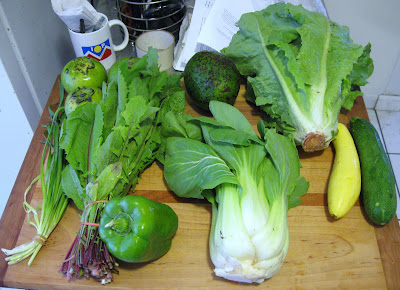Ingredients:
crust:
1 cup flour
1/4 teaspoon salt
6 Tablespoons cold unsalted butter, cut in chunks
2-4 Tablespoons cold water
filling:
1 large zucchini and 1 small summer squash, grated
1 small onion, sliced
2 cloves garlic
3 1/2 ounces well-flavored feta, crumbled
1/3 cup Greek yogurt [I substituted the sour cream I had on hand, but yogurt would be better.]
3 eggs
1 small handful flat leaf parsley, chopped
a little bit of fresh mint leaves, chopped
a little bit of fresh dill, chopped [I was out, but it's a traditional compliment to the other flavors in this dish.]
salt
pepper
pecorino romano or kefalotiri cheese if you can get it
0. Preheat your oven to 425 degrees.
1.
 For the crust, mix the flour and salt in a food processor. Add the butter and pulse several times until the butter is incorporated and the mixture looks a little coarse. Add the water Tablespoon by Tablespoon, pulsing in between, until the dough just barely comes together. Remove the dough to a work surface, work it into a ball, split in half, flatten each piece into a disc, wrap in plastic and chill in the refrigerator for a half hour.
For the crust, mix the flour and salt in a food processor. Add the butter and pulse several times until the butter is incorporated and the mixture looks a little coarse. Add the water Tablespoon by Tablespoon, pulsing in between, until the dough just barely comes together. Remove the dough to a work surface, work it into a ball, split in half, flatten each piece into a disc, wrap in plastic and chill in the refrigerator for a half hour.2. Meanwhile, grate the zucchini and squash (or whatever you've got), mix with 1/4 teaspoon salt, put in a colander and let sit for a half hour. Afterward, squeeze out most of the moisture.
3.
 Heat olive oil and/or butter over medium-high heat in a medium pan. Add the onion and cook for a few minutes, stirring occasionally, until softened and slightly browned. Add the garlic and cook until fragrant. Add the zucchini and cook five minutes more until the zucchini is softened and slightly browned. Remove from heat.
Heat olive oil and/or butter over medium-high heat in a medium pan. Add the onion and cook for a few minutes, stirring occasionally, until softened and slightly browned. Add the garlic and cook until fragrant. Add the zucchini and cook five minutes more until the zucchini is softened and slightly browned. Remove from heat.4. Mix feta, yogurt and eggs in a large bowl. Add the zucchini mixture and the herbs. Add salt and pepper to taste.
5.
 Remove one of the dough discs from the refrigerator and roll out to about 10-inches in diameter. Place it into a 9-inch pie pan and adjust it so it's lining the pan properly. Pour in the filling and grate the romano cheese over top. I folded the excess dough over the top for a bit of the galette feel. You could top the pie with the other half of the dough instead if you'd like. I ended up saving it for another recipe.
Remove one of the dough discs from the refrigerator and roll out to about 10-inches in diameter. Place it into a 9-inch pie pan and adjust it so it's lining the pan properly. Pour in the filling and grate the romano cheese over top. I folded the excess dough over the top for a bit of the galette feel. You could top the pie with the other half of the dough instead if you'd like. I ended up saving it for another recipe.6.
 Bake the pie at 425 degrees for 15 minutes. Reduce the heat to 375 degrees and bake for 25 minutes more until the filling is set and browned and the crust is golden. Cool at least five minutes before serving.
Bake the pie at 425 degrees for 15 minutes. Reduce the heat to 375 degrees and bake for 25 minutes more until the filling is set and browned and the crust is golden. Cool at least five minutes before serving.
The pie filling is fluffy and the crust light and crisp so no faulting it on texture, but I'm disappointed in the lack of a strong zucchini flavor. I would have thought the purging and pan frying would have intensified it, but no. The pie's flavor is mostly just savory eggs, feta tang and fresh herbs. Maybe the zucchini flavors blended with the herbal notes? I think it's in there somewhere. Well, I'm not being judged on my use of the ingredient so it doesn't really matter. What's important is that the results are pretty tasty any which way.















































